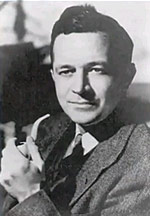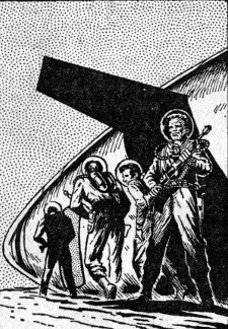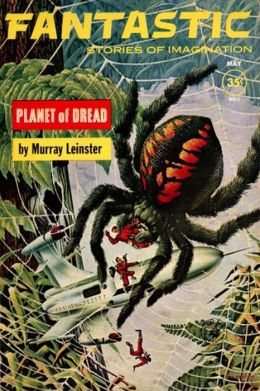Murray Leinster was one of the most productive and creative science fiction writers around. According to wiki :
Murray Leinster (June 16, 1896 – June 8, 1975) was a nom de plume of William Fitzgerald Jenkins, an award-winning American writer of science fiction and alternate history. He wrote and published over 1,500 short stories and articles, 14 movie scripts, and hundreds of radio scripts and television plays.


He is the father of the alternative universe or the invention of parallel universe stories. Leinster's first science fiction story, "The Runaway Skyscraper", appeared in the February 22, 1919 issue of Argosy, and was reprinted in the June 1926 issue of Hugo Gernsback's first science fiction magazine, Amazing Stories. In the 1930s, he published several science fiction stories and serials in Amazing and Astounding Stories (the first issue of Astoundingincluded his story "Tanks"). He continued to appear frequently in other genre pulps such asDetective Fiction Weekly and Smashing Western, as well as Collier's Weekly beginning in 1936 and Esquire starting in 1939.[1]
Leinster is credited with the invention of parallel universe stories. Four years before Jack Williamson's The Legion of Time came out, Leinster published his "Sidewise in Time" in the June 1934 issue of Astounding. Leinster's vision of extraordinary oscillations in time ('sidewise in time') had a long-term impact on other authors, for example Isaac Asimov's "Living Space", "The Red Queen's Race", and The End of Eternity.
He was a genius far ahead of his time imagining something like the Internet, computer networks, A.I. of a sort and all kinds of technological applications long before the world caught even a hint of it.
According to wiki :
He was a genius far ahead of his time imagining something like the Internet, computer networks, A.I. of a sort and all kinds of technological applications long before the world caught even a hint of it.
According to wiki :
Murray Leinster's 1946 short story "A Logic Named Joe" contains one of the first descriptions of a computer (called a "logic") in fiction. In the story, Leinster was decades ahead of his time in imagining the Internet. He envisioned logics in every home, linked through a distributed system of servers (called "tanks"), to provide communications, entertainment, data access, and commerce; one character says that "logics are civilization.
He continued publishing into the 50's and 60's then ending his career in writing in the latter half of the early 60's.
Leinster continued publishing in the 1950s and 1960s, appearing in Galaxy Magazine and The Magazine of Fantasy and Science Fiction, as well as The Saturday Evening Post. He won a Hugo Award for his 1956 story "Exploration Team". Leinster ended his writing career writing novelizations of episodes of the science fiction series Men into Space, The Time Tunnel, and Land of the Giants.
Murray Leinster and I share the birthday of June 16th but on June sixth in 1975 we lost one of the most prolific writers of fiction. Leinster was also an inventor under his real name of William F. Jenkins, best known for the front projection process used in special effects. He also left behind a legacy of over 1,500 short stories and articles, 14 movie scripts, and hundreds of radio scripts and television plays.
His official website is right over
Here are a listing of his wonderful works over at Project Gutenberg. Click on the links to download!
- The Aliens (English) (as Author)
- The Ambulance Made Two Trips (English) (as Author)
- Astounding Stories of Super-Science January 1930 (English) (as Author)
- Attention Saint Patrick (English) (as Author)
- Creatures of the Abyss (English) (as Author)
- The Fifth-Dimension Tube (English) (as Author)
- The Forgotten Planet (English) (as Author)
- The Hate Disease (English) (as Author)
- The Invaders (English) (as Author)
- Invasion (English) (as Author)
- The Leader (English) (as Author)
- The Machine That Saved The World (English) (as Author)
- The Mad Planet (English) (as Author)
- A Matter of Importance (English) (as Author)
-
A Story of the War of 1941-43 (English) (as Author)
- Nightmare Planet (English) (as Author)
- Operation: Outer Space (English) (as Author)
- Operation Terror (English) (as Author)
- Pariah Planet (English) (as Author)
- The Pirates of Ersatz (English) (as Author)
- Planet of Dread (English) (as Author)
- The Red Dust (English) (as Author)
- The Runaway Skyscraper (English) (as Author)
- Sam, This is You (English) (as Author)
- Sand Doom (English) (as Author)
- Scrimshaw (English) (as Author)
- Space Platform (English) (as Author)
- Space Tug (English) (as Author)
- Talents, Incorporated (English) (as Author)
- This World Is Taboo (English) (as Author)Using The Works of Murray Leinster For Your Old School Science Fiction or FantasyCampaign
You can find this one right
HERE
Planet of Dread is typical Leinster, a terraforming project goes incredibly wrong and with no supervision goes completely haywire An expedition is sent in and suddenly we've got astronauts fighting giant insects on an alien world.
.jpg)
Moran cut apart the yard-long monstrosity with a slash of flame. The thing presumably died, but it continued to writhe senselessly. He turned to see other horrors crawling toward him. Then he knew he was being marooned on a planet of endless terrors.

Planet of Dread makes a perfect vehicle for Mutant Future, or a doomed mission to an alternative Carcosa. The whole story lock, stock, and smoking flamethrower would make a hands down kick ass Stars Without Number adventure.
Many of the monsters are straight conversions from the original Monster Manual with some alterations for local colour.
The background makes an excellent post Scream world with lots of room to work within the confines of the SWN universe as a greater part of a sector.
The novella could also be used as an alternative prime material plane for a cross over game of Metamorphosis Alpha first edition and an original D&D adventure. All of the elements are perfect for adding this all to your own adaptation of Planet Of Dread.


No comments:
Post a Comment
Note: Only a member of this blog may post a comment.